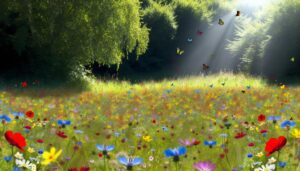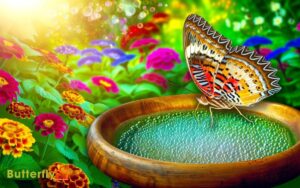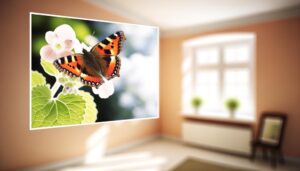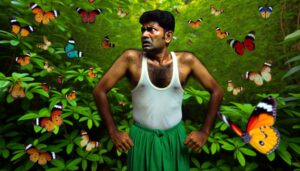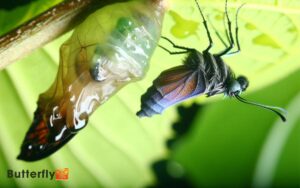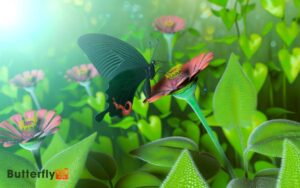Do Butterfly Bushes Attract Bees? Yes!
Yes, butterfly bushes (Buddleja spp.) do attract bees. They produce cone-shaped flower clusters abundant in high-sucrose nectar, which appeals to bees’ olfactory receptors.
Cultivating these bushes in well-drained soil and full sunlight enhances nectar production and bloom longevity. Regular pruning can also boost the aromatic compounds that draw bees.
Variations in flower color and morphology cater to different bee species, making butterfly bushes a versatile choice for supporting pollinators throughout the summer and early fall. Curious about the best practices for maximizing bee attraction?
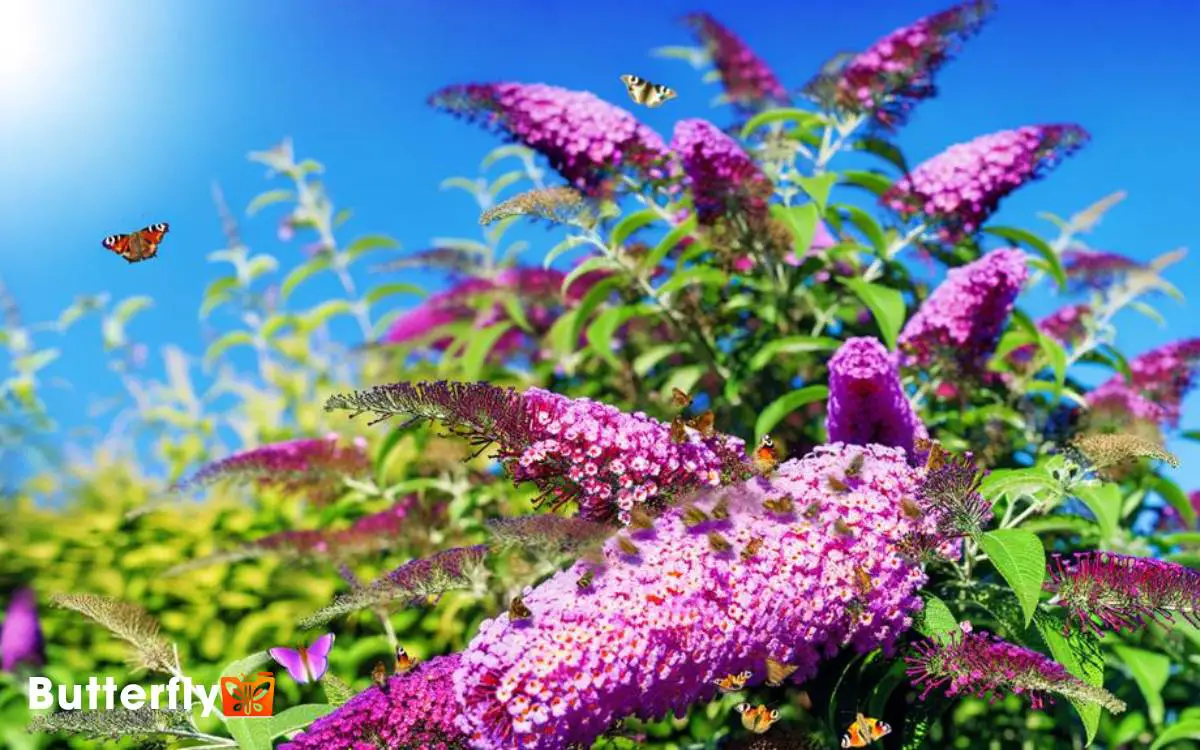
Key Takeaways
Characteristics of Butterfly Bushes
Butterfly bushes, scientifically known as Buddleja, are renowned for their vibrant, cone-shaped flower clusters and resilience in various soil conditions. You’ll find these shrubs can grow up to 10 feet tall, featuring lance-shaped leaves.
Their inflorescences are dense and can range from 4 to 10 inches long, providing an extended bloom period during summer and fall. Buddleja thrives in well-drained soil and full sunlight, although it tolerates partial shade.
Pruning in late winter or early spring encourages vigorous growth and abundant flowering. These bushes are drought-tolerant once established, making them low-maintenance and ideal for xeriscaping. Make sure you water them moderately, avoiding waterlogged conditions.
Flower Colors and Bees
Among the many appealing characteristics of Buddleja, the vibrant flower colors ranging from deep purples and blues to bright pinks and whites play a pivotal role in attracting bees to your garden.
Bees are particularly attracted to blue and purple hues due to their vision spectrum. These colors stand out, signaling nectar-rich flowers. To optimize bee attraction, consider planting a variety of colors to cater to different bee species.
Here’s a useful table summarizing flower colors and their effectiveness in attracting bees:
| Flower Color | Bee Attraction Level | Recommended Buddleja Species |
|---|---|---|
| Deep Purple | High | Buddleja davidii ‘Black Knight’ |
| Bright Pink | Moderate | Buddleja davidii ‘Pink Delight’ |
| White | Low | Buddleja davidii ‘White Profusion’ |
Selecting the right colors enhances pollination and biodiversity.
Scent and Bee Attraction
The aromatic compounds in Buddleja flowers play an essential role in attracting bees, enhancing their foraging efficiency, and promoting pollination. These compounds, primarily volatile organic compounds (VOCs), are critical for signaling resource availability.
Bees have highly sensitive olfactory receptors that detect these VOCs even from a distance. You’ll find that the intensity and composition of these scents can vary, making some Buddleja species more effective at luring bees.
To maximize bee attraction, select butterfly bush varieties known for their strong fragrance, such as Buddleja davidii. Regular pruning can also amplify scent production.
Nectar and Pollen Availability
When selecting butterfly bushes, you should take into account their flowering seasons to guarantee continuous nectar availability for bees. Choose varieties recognized for high nectar production to attract and support bee populations.
Additionally, evaluate the structural characteristics of the flowers to make sure pollen is easily accessible.
Flowering Seasons Matter
To maximize nectar and pollen availability for bees, understanding the specific flowering seasons of butterfly bushes is crucial.
Butterfly bushes (Buddleja spp.) typically bloom from summer to early fall, aligning well with the active foraging period of many bee species. By planting these bushes, you guarantee a consistent food source during these critical months.
You should also consider the variety of butterfly bush, as different cultivars might’ve slightly varied flowering times. Monitoring local climate patterns and adjusting planting schedules can further optimize nectar production.
Additionally, stagger planting dates or select multiple cultivars to extend the flowering period. This strategy provides continuous nectar and pollen, thereby supporting bee populations effectively through their peak activity months.
High Nectar Production
For maximizing nectar and pollen availability, focus on selecting butterfly bush varieties known for their high nectar production levels. You’ll want to guarantee that your garden provides ample resources for bees.
Not all butterfly bushes are created equal; some produce more nectar than others, making them more attractive to pollinators.
Consider these factors when choosing a variety:
- Cultivar Selection: Varieties like Buddleja davidii are renowned for their copious nectar output.
- Flower Density: Opt for bushes with dense flowering clusters, as they offer more nectar per plant.
- Bloom Duration: Select varieties that bloom over extended periods to provide consistent nectar sources.
Pollen Accessibility Factors
Ensuring pollen accessibility involves considering flower morphology and the ease with which bees can forage nectar and pollen.
You’ll want to evaluate how the shape and size of Butterfly Bush flowers influence bee foraging behavior. Tubular flowers may seem important, but their nectar-rich structure attracts bees that can navigate these depths.
Evaluate if the stamen and pistil are positioned to facilitate pollen transfer onto visiting bees. Additionally, check the flower’s bloom density and duration; continuous bloom periods guarantee ongoing pollen availability.
High nectar production can enhance the attractiveness of the flowers, but don’t overlook pollen accessibility, as it’s essential for bee nutrition. Properly analyzing these factors will make your Butterfly Bushes a prime foraging choice for bees.
Expert Opinions on Bee Appeal
Entomologists assert that butterfly bushes (Buddleja spp. ) possess a combination of vibrant colors and rich nectar that irresistibly attracts bees. These shrubs serve as a valuable food source for pollinators, supporting local ecosystems and promoting biodiversity. However, gardeners should be mindful of their landscaping choices, as cedar mulch repels butterflies and may inadvertently deter these delicate insects from visiting their gardens. By selecting appropriate ground coverings and companion plants, enthusiasts can create a more inviting habitat for both butterflies and bees.
Experts highlight three primary reasons:
- Nectar Abundance: Buddleja flowers produce copious amounts of high-sucrose nectar, providing bees with essential energy.
- UV Reflection: The flowers exhibit ultraviolet patterns visible to bees, enhancing foraging efficiency.
- Extended Bloom Period: Butterfly bushes offer a prolonged flowering season, guaranteeing a consistent nectar source.
To maximize bee attraction, you should consider proper planting techniques. Position your Buddleja in full sun and ensure well-drained soil. Regular pruning can stimulate more blooms, thereby providing an extended foraging period for bees.
Comparative Analysis With Other Plants
While butterfly bushes offer numerous benefits for attracting bees, it’s important to compare their effectiveness with other bee-friendly plants like lavender, sunflowers, and clover.
Lavender, with its high nectar production and prolonged blooming period, consistently draws bees. Sunflowers provide abundant pollen and are particularly attractive to bumblebees.
Clover, especially white and red varieties, is a favorite due to its high nectar yield and ease of access for bees.
Butterfly bushes (Buddleja spp.) produce large clusters of tubular flowers rich in nectar, appealing primarily to butterflies and bees. However, they may not match the extensive foraging opportunities presented by lavender or clover.
When designing a pollinator-friendly garden, consider a diverse planting scheme to maximize bee attraction and support their nutritional needs.
Seasonal Blooming Patterns
You should understand the peak bloom times of butterfly bushes to maximize their attractiveness to bees. These plants typically bloom from mid-summer to early fall, with variations based on regional climates.
Monitoring their flowering duration and seasonal changes will help you optimize garden planning and bee activity.
Peak Bloom Times
Understanding the peak bloom times of butterfly bushes is essential for maximizing their effectiveness in attracting bees throughout the growing season. Butterfly bushes (Buddleja davidii) typically exhibit peak blooming periods during mid-summer to early autumn.
To optimize bee attraction, you should focus on these vital points:
- Mid-Summer Blooms: Expect an explosion of flowers from late June to August, providing ample forage for bees.
- Late Summer to Early Fall: The blooming continues robustly into September, ensuring a steady nectar supply.
- Climate Influence: Regional climatic conditions can slightly shift these peak times, so monitor local weather patterns.
Flowering Duration
Butterfly bushes have a prolonged flowering duration, typically spanning from late spring through the first frost, ensuring a continuous nectar source for bees.
This extensive blooming period is critical for maintaining bee populations, especially during times when other floral resources are scarce.
You’ll find that butterfly bushes (Buddleja spp.) produce copious clusters of tubular flowers, which are highly attractive to bees due to their rich nectar content.
Here’s a concise summary of the flowering duration:
| Season | Start | End |
|---|---|---|
| Late Spring | May | June |
| Summer | June | August |
| Early Fall | September | First Frost |
Seasonal Variations
Seasonal variations in blooming patterns directly influence the availability of nectar, making butterfly bushes an essential resource for bees throughout the year.
Understanding these variations can help you optimize your garden for bee activity. Butterfly bushes generally bloom from summer to early fall, providing a consistent nectar supply.
- Early Bloom: In milder climates, some varieties may start blooming as early as late spring, extending the nectar availability period.
- Peak Bloom: Most butterfly bushes reach their peak bloom in mid-summer, attracting the highest number of bees.
- Late Bloom: Certain species continue to produce flowers into early autumn, offering late-season sustenance for bees.
Real Gardeners’ Experiences
Listening to seasoned gardeners reveals that butterfly bushes not only attract a variety of bees but also support their foraging habits effectively. These gardeners have observed diverse bee species, including honeybees and bumblebees, frequenting the vibrant blooms.
They emphasize planting butterfly bushes in sunny spots to maximize nectar production, which directly benefits bee activity.
| Experience | Observation |
|---|---|
| Planting Location | Sunny spots increase nectar production. |
| Bee Species | Honeybees, bumblebees, and solitary bees frequent the bushes. |
| Bloom Period | Extended blooming periods sustain bee foraging. |
Environmental Factors
To optimize your butterfly bushes for attracting bees, make sure they receive full sunlight and well-drained soil with a pH between 6.0 and 7.5.
Consider that these plants thrive in USDA hardiness zones 5 through 9, where average annual temperatures and rainfall support their growth.
Monitoring these environmental factors will help you create an ideal habitat for both the bushes and the bees they attract.
Soil and Sunlight Requirements
Butterfly bushes thrive best in well-drained soil and full sunlight, ensuring ideal growth and vibrant blooms.
To optimize conditions, follow these guidelines:
- Soil Composition: Confirm the soil is loamy and pH-balanced (6.0-7.0). Avoid clay-heavy soils that retain water.
- Sunlight Exposure: Position your butterfly bush in an area receiving at least 6-8 hours of direct sunlight daily. Insufficient light can stunt growth.
- Watering Practices: Though drought-tolerant, maintain moderate moisture during the establishment phase. Over-watering can lead to root rot.
Climate Impact on Growth
Understanding the impact of climate on butterfly bush growth is crucial for ensuring their health and longevity. Butterfly bushes (Buddleja davidii) thrive in USDA zones 5-9, where they benefit from moderate temperatures and well-drained soil.
Extreme cold can cause dieback, while excessive heat stresses the plant, reducing its flowering capacity. You’ll want to monitor rainfall, as too much water can lead to root rot, yet drought conditions also impair growth.
Here’s a quick reference table to help visualize ideal conditions:
| Factor | Ideal Condition | Impact of Deviation |
|---|---|---|
| Temperature | 60-85°F | Cold: Dieback, Heat: Stress |
| Rainfall | 1 inch/week | Excess: Root rot, Drought: Wilting |
| Soil Drainage | Well-drained | Poor: Root disease |
| Sunlight | Full sun | Shade: Reduced blooms |
| Humidity | Moderate | High: Fungal issues |
Understanding these factors, you can create a favorable environment for your butterfly bushes.
Enhancing Bee Attraction
Maximize bee attraction by selecting butterfly bush varieties with high nectar production and vibrant colors. Different species and cultivars offer varying levels of nectar and visual appeal, so your choices directly impact bee activity.
To enhance attraction, consider these steps:
- Choose high-nectar cultivars: Opt for varieties like Buddleja davidii ‘Black Knight’ or ‘Nanho Blue’, known for abundant nectar.
- Focus on vibrant colors: Bees are particularly attracted to blue, purple, and yellow hues.
- Plant diversity: Integrate multiple butterfly bush species to provide a continuous nectar source throughout the blooming season.
Conclusion
So, you’ve planted a butterfly bush expecting a bee bonanza, huh? Well, congrats! While they’re not the Michelin-star restaurant bees dream of, they’ll grudgingly settle for your “all-you-can-eat” nectar buffet.
Remember, though, your bush’s flower colors, scent, and seasonal blooming patterns will dictate the bee turnout. Add some water sources and diverse plants to up your game.
Don’t worry, your garden won’t become the next insect Woodstock, but it’ll buzz with begrudging bee approval.

